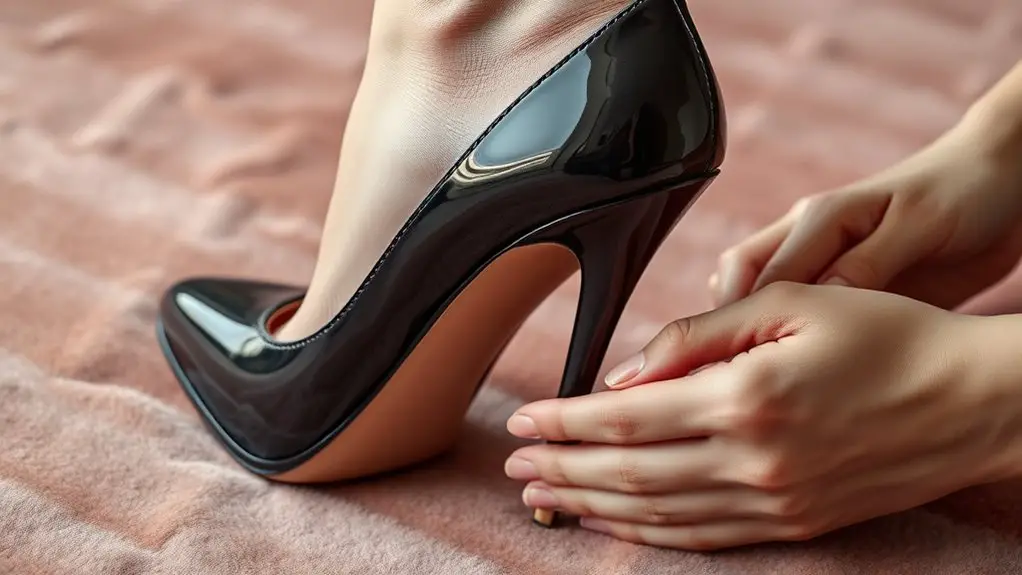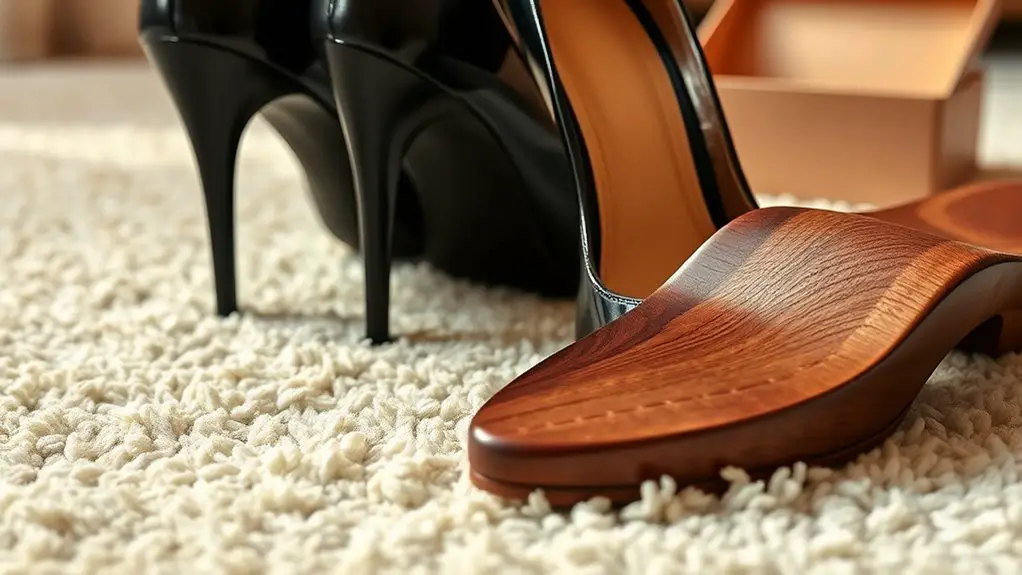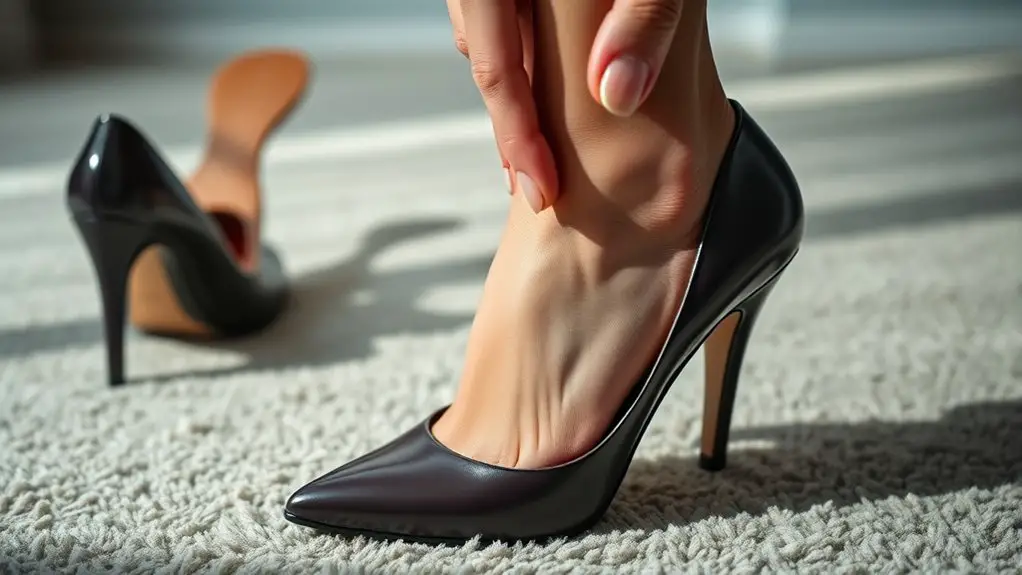If your heels feel too tight, it’s often due to improper sizing, rigid materials, or your foot shape not being accommodated. These factors can exacerbate discomfort and limit movement. To alleviate tightness, try effective stretching techniques like calf stretches and towel stretches. Strengthening exercises can also provide support. Prioritizing proper shoe selection and fit can help prevent future discomfort. Stay tuned to learn more about caring for your feet and choosing the right shoes.
Understanding the Anatomy of High Heels

High heels are more than just a fashion statement; they are intricately designed footwear that alters the body’s posture and gait. The heel structure plays a critical role in this transformation. Typically elevated, the heel shifts weight distribution, affecting foot mechanics considerably. When you wear high heels, your center of gravity moves forward, forcing your body to compensate by adjusting posture. This can lead to an unnatural alignment of the spine and increased pressure on the forefoot.
Understanding the mechanics involved is essential for recognizing how high heels can impact your overall foot health. The elevated heel may cause the Achilles tendon to shorten over time, impacting movement efficiency and leading to discomfort. Additionally, the rigid structure of high heels limits the natural flexion of the foot, inhibiting its ability to adapt to various surfaces. Awareness of these aspects can help you make informed choices about heel usage and foot care.
Common Causes of Tightness in Heels
Tightness in your heels can often stem from improper shoe sizing, which restricts your foot’s natural movement. Additionally, materials with high rigidity can exacerbate discomfort by failing to adapt to the shape of your foot. Understanding these causes is essential for identifying effective solutions.
Improper Shoe Sizing
When shoes don’t fit properly, it can lead to significant discomfort, particularly in the heel area. One common cause of this issue is improper shoe sizing, which often stems from a mismatch between your foot width and the shoe’s design. If you select shoes that are too narrow for your foot width, the pressure on your heels can cause pain and irritation. Additionally, an inadequate shoe fit can lead to instability, making it difficult for your heel to sit comfortably within the shoe. It’s important to measure your feet regularly and try on various styles to guarantee ideal shoe fit. Remember, a proper fit not only enhances comfort but also supports overall foot health, reducing the risk of long-term complications.
Material Rigidity Issues
Although you might not realize it, the materials used in your shoes can greatly contribute to heel discomfort. Rigid materials often lack the necessary material flexibility, which can lead to a constricting fit around your heels. Shoes made from stiff leather or synthetic materials may prioritize shoe durability over comfort, resulting in tightness. This rigidity restricts natural foot movement and can exacerbate pressure points. Additionally, when shoes don’t adapt to the shape of your foot, you may experience increased friction and discomfort. To alleviate this issue, consider choosing shoes crafted from more flexible materials or utilizing stretching techniques to enhance the fit. Prioritizing both material flexibility and comfort can markedly improve your overall wearing experience.
The Role of Shoe Materials and Construction

Shoe materials and construction play an essential role in determining comfort and fit, particularly for those with tight heels. The choice of materials directly affects shoe flexibility and can either enhance or restrict movement. For instance, shoes made from rigid materials often lack the necessary give to accommodate your foot shape, leading to discomfort.
Conversely, flexible materials allow for better adaptation to your foot, reducing tightness in the heel area. Additionally, material breathability is vital. Breathable fabrics help regulate temperature and moisture, contributing to overall foot comfort. Shoes that trap heat and moisture can exacerbate discomfort, making tight heels feel even tighter.
When selecting shoes, consider both the materials and construction methods used. A well-constructed shoe with a balance of flexibility and breathability will promote a more comfortable fit, ultimately alleviating pressure on your heels and enhancing your overall walking experience.
Assessing Your Foot Shape and Size
To effectively stretch tight heels, you need to understand your foot’s anatomy and dimensions. Start by measuring your foot’s length and width to determine your size and shape. This assessment is essential for selecting the appropriate footwear and stretching techniques tailored to your specific needs.
Understanding Foot Anatomy
Understanding your foot anatomy is fundamental for addressing tight heels effectively. Your foot structure consists of bones, ligaments, tendons, and muscles, all working together to support your weight and enable movement. A key component is the arch, which plays a significant role in shock absorption and overall stability. When your shoes lack proper arch support, it can lead to excess pressure on your heels, causing discomfort and tightness. It’s essential to recognize your unique foot shape, as this determines the type of support you need. Flat, high-arched, or neutral feet each require different footwear characteristics to guarantee ideal comfort and function. By understanding your foot’s anatomy, you can choose appropriate shoes and prevent tight heels from becoming a persistent issue.
Measuring Foot Dimensions
Measuring your foot dimensions is vital for accurately evaluating your foot shape and size, as even slight variations can greatly impact comfort and fit. To achieve precise measurements, utilize various foot measurement techniques, including the Brannock device or a simple ruler. The Brannock device provides a thorough assessment, measuring both length and width, while a ruler can offer a quick, albeit less detailed, alternative. When conducting a measuring tools comparison, consider factors such as accuracy, ease of use, and availability. It’s important to measure your feet at the end of the day when they’re most swollen, ensuring a better fit. Accurate measurements help you select footwear that accommodates your unique foot shape, ultimately enhancing comfort and reducing the risk of tightness.
Effective Techniques to Stretch Your Heels

When tightness in your heels becomes a daily discomfort, incorporating effective stretching techniques can greatly enhance your mobility and alleviate pain. Start with heel exercises like the calf stretch. Stand facing a wall, place your hands on it, and step one foot back, keeping it straight while bending the front knee. Hold this position for 15-30 seconds and switch sides.
Another technique involves sitting down with one leg extended. Loop a towel around the ball of your foot, gently pulling towards you while keeping your knee straight. Hold for 15-30 seconds.
Additionally, consider using a tennis ball; place it under your foot and roll it back and forth to massage the heel area. These stretching techniques can help improve flexibility, reduce tension, and ultimately provide relief. Regular practice of these heel exercises will contribute considerably to your overall foot health.
When to Seek Professional Help
Despite the benefits of stretching techniques for tight heels, there are instances when self-care may not suffice. If you experience persistent pain, swelling, or discomfort that doesn’t improve with stretching, it’s time to reflect on when to seek professional help. A healthcare provider can assess your condition and identify underlying issues, such as plantar fasciitis or heel spurs.
If you notice changes in your gait, or if your tightness interferes with daily activities, don’t hesitate to consult a specialist. Additionally, if you have a history of foot-related problems or systemic conditions like diabetes, seeking professional help is vital. Your healthcare provider may recommend physical therapy, custom orthotics, or other interventions tailored to your needs. Acting promptly can prevent further complications and guarantee you regain comfort and mobility in your heels. Remember, early intervention is key to effective treatment and recovery.
Preventing Future Discomfort in Heels
To prevent future discomfort in your heels, it’s crucial to adopt a proactive approach that includes proper footwear, regular stretching, and strengthening exercises. Start by investing in shoes that provide adequate support and cushioning, ensuring they fit well to reduce pressure on your feet. Incorporate preventive measures such as daily stretching routines focusing on the calves and Achilles tendon, which can enhance flexibility and alleviate tension. Strengthening exercises for the foot and ankle can also improve stability and reduce the risk of injury. Additionally, prioritize foot care by maintaining proper hygiene, moisturizing, and regularly inspecting your feet for any signs of irritation or discomfort. By integrating these practices into your routine, you can greatly reduce the likelihood of experiencing tightness or pain in your heels, promoting long-term foot health and comfort. Remember, a little effort now can lead to substantial benefits in the future.
Choosing the Right Pair for Comfort and Style
Selecting the right pair of shoes is essential for achieving both comfort and style. When choosing heels, consider key comfort factors like arch support, cushioning, and heel height. A moderate heel height often provides a balance between aesthetic appeal and foot health. Look for shoes with padded insoles and breathable materials to enhance comfort during extended wear.
Stylish options abound, so you don’t have to sacrifice fashion for function. Consider classic styles like block heels or wedges that offer stability and elegance. Additionally, evaluate the shoe’s fit; it should allow for slight wiggle room in the toes without being loose.
Lastly, pay attention to the shape of your foot. Everyone’s feet are unique, and selecting shoes that accommodate your specific foot shape will further enhance comfort while keeping you stylish. By prioritizing these factors, you’ll find a pair that meets your needs effectively.
Frequently Asked Questions
Can Wearing Heels Cause Permanent Foot Damage?
Yes, wearing heels can cause permanent foot damage. The increased heel pressure alters your foot structure over time, leading to issues like bunions, hammertoes, and chronic pain, which may require medical intervention or corrective measures.
How Often Should I Replace My High Heels?
You should replace your high heels every 6 to 12 months, depending on high heel lifespan and shoe material impact. Worn-out heels can lead to discomfort and potential foot issues, so keep an eye on them!
Are There Specific Brands Known for Comfort?
Yes, specific comfort brands like Clarks and Naturalizer prioritize soft shoe materials and ergonomic designs. They often use cushioned insoles and flexible outsoles, enhancing overall comfort, particularly for extended wear in high heels.
Do Orthopedic Inserts Help With Heel Discomfort?
Orthopedic inserts can greatly improve heel discomfort by providing essential heel support. They offer orthopedic benefits, helping alleviate pressure and align your foot properly, which can lead to reduced pain and enhanced comfort during daily activities.
Can Weight Gain Affect Heel Tightness?
Yes, weight gain can affect heel tightness due to increased pressure on your foot anatomy. Excess weight may lead to inflammation and strain on surrounding tissues, potentially causing discomfort and tightness in the heel area.



